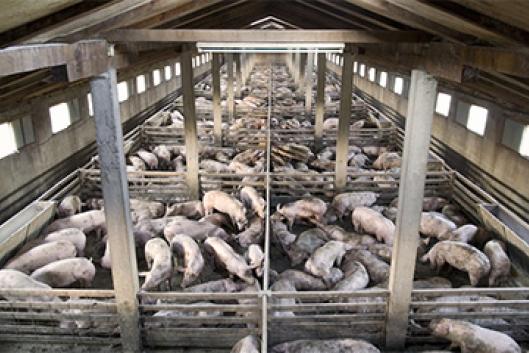Silvia Ribeiro, ETC Group
The industrial breeding of animals in confinement (poultry, pig, bovine) is a real factory for animal and human epidemics. On these farms, there are huge concentrations of overcrowded, genetically-uniform animals with weakened immune systems, to whom antibiotics are continuously administered. This latter point, according to the World Health Organization (WHO), is the main cause of global resistance to antibiotics. It is a perfect breeding ground for more lethal mutations of viruses, and for bacteria that are multi-resistant to antibiotics—which are later distributed throughout the world following the routes of free trade.
Rob Wallace, US biologist and author of the book, Big Farms make Big Flu, thoroughly documented this process, analyzing outbreaks of new viruses of animal origin: avian and swine flus, Ebola, Zika, HIV and others. A large number of them originated on industrial farms, and others in wild animals, such as the Covid-19 coronavirus that came from bats. But to date, studies indicate that Covid-19 would not have reached humans, had it not been for intermediaries. The study of its genetic makeup suggested the intermediaries could have been pangolins, small mammals that live in Asia; but the same study pointed out that it could have been other animals—such as pigs. The organization, GRAIN, reported on the existence of mega- pig farms in the province of Hubei, of which Wuhan is the capital (1).
At the same time that Covid-19 was detected, China’s large pig farms were devastated by another virus that affected and killed millions of pigs: African swine fever (2). Fortunately, it has not mutated (yet) into an infectious virus for humans, but it is growing throughout China and Europe.
The baneful relationship between industrial livestock and epidemics/pandemics goes beyond large farms and extends throughout the whole industrial agricultural system. Viruses originating from wild animals reach farms, or rural and urban areas, because of the destruction of biodiverse habitats—habitats that could have functioned as barriers to contain the spread of viruses from wild animal populations.
The main culprits for this destruction of ecosystems are the agribusiness food system as a whole (monocultures, farms, contamination of soils and water sources), uncontrolled urban growth, and the onslaught of megaprojects in these areas—such as mining, dams, highways and commercial corridors.
In this context, the agroindustrial food system also plays a key role in the devastation of biodiversity: the main cause of deforestation worldwide is the expansion of the industrial agricultural frontier. In Latin America, this causes 70% of deforestation on average, and in Brazil up to 80%, according to data from the FAO.
Additionally, of all the agricultural land on the planet, over 70 percent is used for the livestock industry (pasture or forage), the vast majority of which is industrial. More than 60 percent of the grain grown worldwide is to feed animals in confinement (3). What is even worse, some governments’ measures to allegedly control the Covid-19 pandemic are, in fact, accelerating land-grabbing in forests. Agroindustrial multinational corporations, including giants like Bayer-Monsanto, are among the industries that have benefitted from the pandemic—reporting huge profits despite the health crisis.
Therefore, attributing the problem of the pandemic to the consumption of wild meat is absurd. In fact, it successfully diverts our attention from seeing the destructive role of the industrial agricultural-livestock food system, which is already engendering other pandemics in this very moment—since nothing has changed yet. Worse still, the meat processing industries have been hotbeds of Covid-19 infections in the United States and Europe.
By contrast: Traditional, small-scale, decentralized, peasant and pastoral farming of domestic animals—or the traditional consumption of wild meats within limits decided upon by communities—is part of indigenous and peasant communities’ survival. These communities maintain and even increase diversity, and prevent pandemics. Moreover, peasant networks—including fisherfolk, herders and urban gardeners—provide food for 70% of humanity, with less than 25 per cent of the land, water and resources (4).
(1) GRAIN, New research suggests industrial livestock, not wet markets, might be origin of Covid-19, March 2020,
(2) GRAIN, African Swine Fever: Building a factory-farmed future, one pandemic at a time, March 2020
(3) Grupo ETC, Con el caos climático, ¿quién nos alimentará? ¿La cadena industrial de producción de alimentos o las redes campesinas?, 2014,
(4) Grupo ETC; ¿Quién nos alimentará?, 2017
>>> See here all the Reflections amid the Covid-19 Pandemic from WRM’s Advisory Committee
